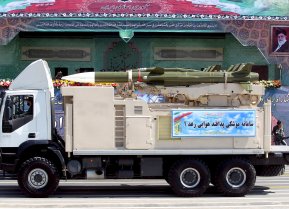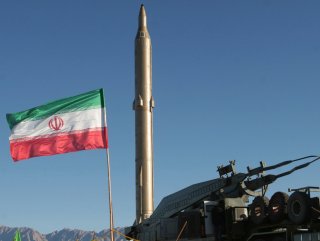Why Iran Isn’t Trying to Get a Nuclear Weapon (Right Now)
Rushing to a nuclear weapon today would be a terrible mistake for Iran, and Tehran knows it.
On January 4, 2021, Iran announced that it would begin enriching uranium at the 20 percent level—far exceeding the 3.67 percent limitation set under the Joint Comprehensive Plan of Action (JCPOA). A month later, the regime began producing uranium metal—a key component of nuclear weapons. The United Kingdom, France, and Germany responded by saying that the moves by Iran had “no credible civil justification.” In plain English, that means the only plausible technical purpose for those steps is to develop a nuclear weapon.
However, the steps Iran has taken in the past two years are not those of a regime mounting a covert bid to develop a nuclear weapon, the way that North Korea did in the early 2000s. Iran has taken such a path before, when the regime began a secret nuclear weapons program in 1989, called the AMAD Plan. The full scope of this project was only understood in 2018 when Israeli agents smuggled out tons of documents from a tightly guarded Iranian warehouse.
The secrecy of that weapons program stands in stark contrast to Iran’s behavior today. Every time Iran increases its uranium enrichment level, the regime organizes a press conference in Tehran to announce the steps with dozens of journalists in attendance. The technical steps are announced in English and shared with the International Atomic Energy Agency.
So why is Iran enriching uranium at this level? It is not to generate energy, medicine, or even at this time for a nuclear weapon—it’s to generate fear and concern in Washington and European capitals that Iran might get a nuclear bomb. It’s much like the brother who dangles a sibling over a railing—not because he actually intends to drop the sibling (and face the parents’ inevitable wrath), but because he wants to inspire panic. Iranian officials hope this fear will turn into negotiating leverage to relieve sanctions. Mohsen Rezaie, one of Supreme Leader Ali Khamenei’s top advisors, confirmed this tactic on March 13 when he called for Iran to increase enrichment to 60 percent, “because this will lead to the lifting of sanctions by the United States.” If the United States returns to the JCPOA, this nuclear blackmail will have proven enormously successful.
The JCPOA provides an ideal cover for the regime to engage in its foreign policy of destabilizing and sectarian violence free of major economic sanctions. Even sweeter, the deal provides Iran with an easier and internationally legitimized path to a nuclear weapon, as restrictions on Iran’s nuclear program under the JCPOA begin to expire just three short years from now. As President Barack Obama once admitted, “in year 13, 14, 15 [of the deal], they have advanced centrifuges that enrich uranium fairly rapidly and at that point, breakout times would have shrunk almost down to zero.” Indeed. Not only will President Obama’s concerns come true, but the regime could also develop nuclear weapons on the back of a revived Iranian economy that would easily afford advanced missile systems to defend against would-be spoilers.
Rushing to a nuclear weapon today would be a terrible mistake for the regime, and they know it. The past five U.S. presidents have declared that Iran will not be allowed to obtain a nuclear weapon. Israeli Prime Minister Benjamin Netanyahu has similarly pledged that Israel “will do everything” to ensure Iran does not obtain a weapon, and we would be wise to believe him. President Obama is reported to have barely convinced Israel not to bomb Iran’s nuclear facilities. Iran is not so foolish to risk antagonizing Israel so long as Bibi holds the reins.
Today, Iran can’t even protect its facilities from sabotage or keep its top nuclear scientists alive. But ten years from now, with Netanyahu gone and the United States kept busy sparring with China, they could easily have purchased and set-up the S-400 or S-500 missile defense system from Russia, who seems quite inclined to oblige. Levan Dzhagaryan, the Russian ambassador to Tehran, said in October 2020 that selling the S-400 to Iran would be “no problem.” And while Iran waits for its nuclear restrictions to expire, the regime can further develop its ballistic missile arsenal as a strong conventional deterrent and fortify its nuclear facilities from U.S. and Israeli strikes. Once these risk-reducing measures have been completed, Iran will want its nuclear weapon and its fabled fatwa will find a convenient caveat.
It’s a simple plan only ten years away from fruition, as long as the regime can succeed in restoring the JCPOA. To bolster its threat perception, Iran wants the world to think it is on the verge of a nuclear weapon. Unfortunately, they have been ably assisted in this endeavor by Secretary of State Antony Blinken and a slew of European officials who keep repeating open-source estimates that Iran’s “breakout timeline” is down to a few months. This is highly misleading and Blinken knows it.
There are two separate breakout timelines: the first one Secretary Blinken regularly cites is the amount of time it would take for Iran to obtain enough nuclear material enriched at the 90 percent weapons-grade level required for one bomb. The Israelis, who know a thing or two about Iran’s nuclear program, say this timeline is double the length that Blinken quotes. But there is a far more important timeline that he purposefully neglects to mention: the time required to develop an operational nuclear warhead. The estimate of this weaponization timeline is officially classified by the U.S. government, but in early February, Major General Tamir Heiman of Israel’s Military Intelligence Directorate disclosed Israel’s estimate that Iran was still two years away from developing a nuclear weapon, once it decides to do so.
On top of that, neither the U.S., European, nor Israeli governments have publicly claimed that the Iranian government is actively pursuing a nuclear weapon, an event that would start the clock on this two-year countdown. That’s an important cue policymakers in Congress should pay close attention to. The IAEA should also actively monitor and publicly report on the weaponization process—while they have reported on significant Iranian deception and obfuscation surrounding its nuclear program, they have yet to assess Iran is actively working on a nuclear device.
The good news is that we are still a long way away from Iran obtaining a nuclear weapon. The greatest mistake we could make is to fall victim to Iran’s threats and rashly return to the JCPOA. That path has one terrifying and predictable end: a nuclear-armed Iran. We have the time now to negotiate from a position of strength and demand a deal that permanently shutters Iran’s nuclear ambitions.
Gabriel Noronha served as the Special Advisor for the State Department’s Iran Action Group from 2019-2021, where he worked on Iran’s nuclear program. He previously served as Special Assistant to the Senate Armed Services Committee under Chairmen John McCain and Jim Inhofe.
Image: Reuters.


